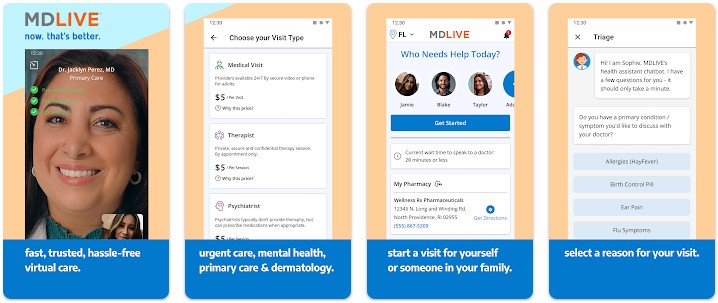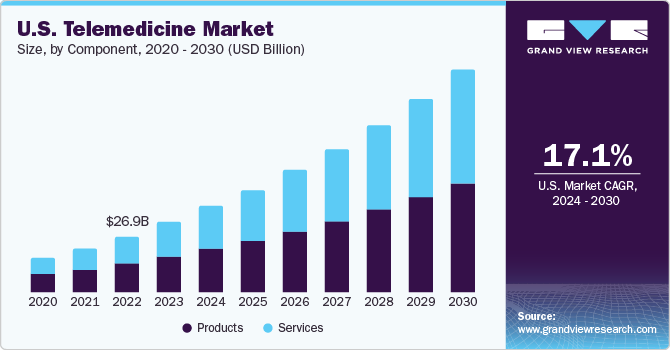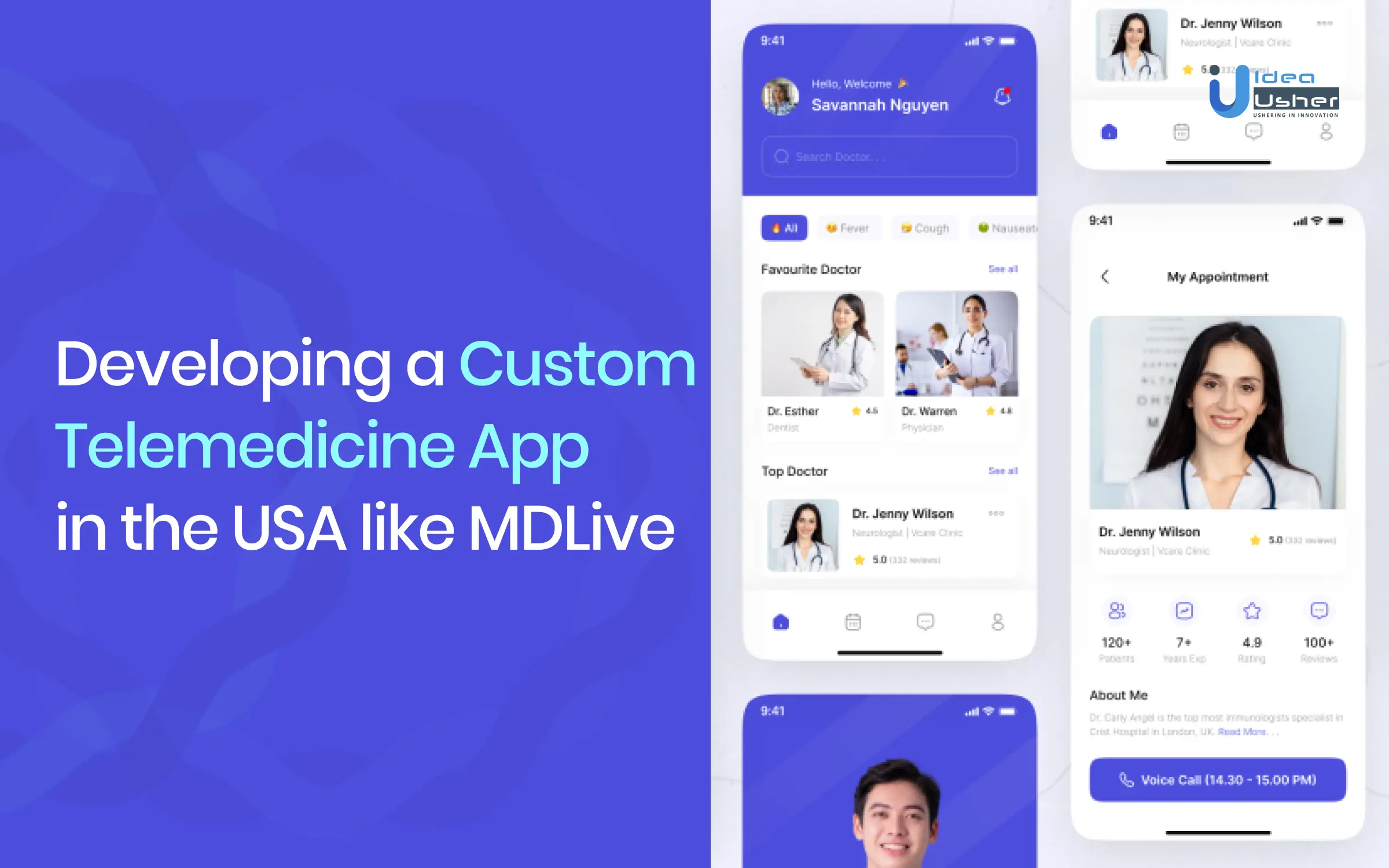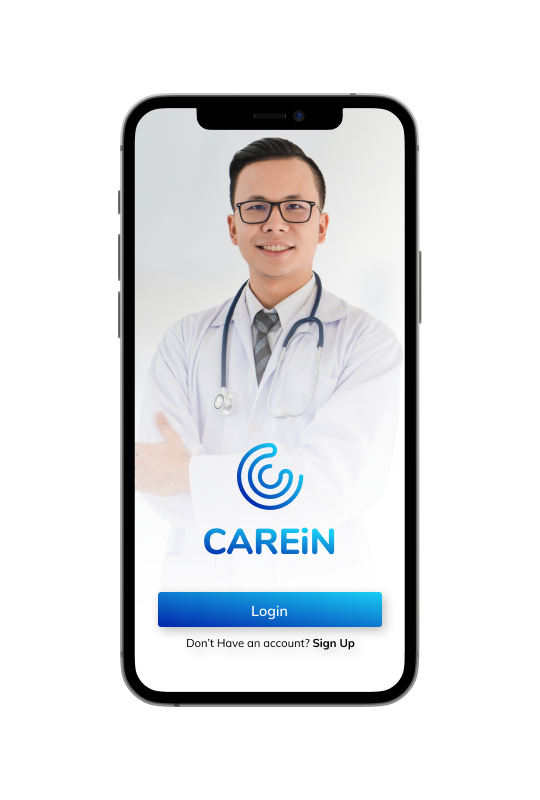A telemedicine app offers a solution to the challenge of reaching medical care in remote areas or during busy schedules. It also reduces the need for time-consuming travel as well as long wait times. Apart from this, the growing dependency on mobile apps for healthcare is driven by the increasing demand for convenience and efficiency, which is proven by the fact that the global telehealth market is expected to soar to $286.22 billion by 2030.
There are several telemedicine apps that we have mentioned in the blog below, but among all of them, MDLive is the best as it addresses health issues by providing 24/7 online access to healthcare professionals and its comprehensive services, including primary care, mental health support, and all the medical help you need.
In this blog, we will go through the process of developing a custom telemedicine app like MDLive, offering practical advice on essential features, technology choices, and strategies to build a competitive platform that meets the demand for remote healthcare solutions.
MDLive: Overview

MDLive is a telemedicine app that lets you connect with doctors and other healthcare professionals through video or phone calls. It was launched in 2009, and it offers quick and convenient access to medical care for people across the US, especially those in remote areas or with busy schedules.
MDLive allows its users to get help for a variety of health issues, such as primary care, mental health, and skin problems, without needing an in-person appointment. Doctors are available 24/7, and most users can talk to a doctor within minutes for non-emergency issues.
The app works with many insurance plans, making it a more affordable option for healthcare. MDLive also uses secure technology to protect your personal information, ensuring your privacy during consultations. Basically, this app gained popularity due to its ability to provide convenient, accessible, and affordable healthcare services.
What Makes The MDLive Unique?
The MDLIVE app provides a comprehensive range of telehealth services, offering:
- Appointment Flexibility: Easily schedule, reschedule, or cancel appointments with healthcare professionals.
- Virtual Consultations: Connect with board-certified doctors and licensed therapists for secure, real-time consultations covering physical and mental health needs.
- Provider Messaging: Communicate directly with your healthcare provider, enabling easy follow-ups.
- Insurance Updates: Quickly update your insurance details within the app for a smooth billing process.
- Prescription Management: Request renewals, track medications, and manage refills effortlessly.
- Primary and Urgent Care: Access care for chronic conditions or non-emergency issues like flu or allergies.
| Patient Panel | Provider Panel | Admin Panel |
| Schedule and change appointments | Manage appointments | Manage user accounts |
| Access virtual consultations | View patient information | Manage provider accounts |
| View messages from providers | Conduct virtual consultations | System administration tasks |
| Update insurance information | Prescribe medication | Monitor system performance |
| Manage health records | Access patient medical history | Generate reports |
| Request and manage prescriptions | Communicate with patients | Manage billing and payments |
| Access urgent care services | Update patient records | Ensure compliance with regulations |
| Access mental health services | Provide treatment plans | Manage insurance information |
| Access primary care services | Coordinate with other healthcare providers | Handle technical support issues |
Key Market Takeaways For Telemedicine Apps

- The global telehealth market was valued at $114.98 billion in 2023 and is expected to grow at a 17.96% annual rate from 2024 to 2030, according to Grand View Research.
- In-person healthcare is expensive, making telehealth a significant opportunity for cost savings.
- McKinsey estimates that $250 billion of current US healthcare spending could be shifted to virtual care, including psychiatric services, chronic condition check-ins, and professional training.
- Telehealth services can be accessed conveniently through patients’ preferred devices, making healthcare more accessible and flexible.
How Profitable Are Telemedicine Apps Like MDLive?
Telemedicine apps like MDLive are proving to be very profitable. Here’s why:
- Growing Market: The telemedicine industry is expanding quickly, with an expected annual growth rate of 17.2%. It’s projected to reach $286.22 billion by 2030, showing strong growth in the coming years.
- Increased Use: More people are using telehealth services than ever before. The number of telehealth visits has jumped to 38 times the level it was before the pandemic, indicating a big rise in demand.
- Different Ways to Make Money: Apps like MDLive earn money through various methods, including subscription fees, charges for each visit, and partnerships with healthcare providers and insurance companies. This variety helps them generate steady income.
- Lower Costs: Telemedicine cuts down on expenses related to in-person visits, like travel and facility costs. This makes it cheaper for both patients and providers, which helps the app’s profitability.
- Wider Access: These apps make healthcare accessible to people in remote or underserved areas, expanding their user base and boosting revenue opportunities.
Most Popular Telemedicine Apps in the US Market
Here are five popular telemedicine apps in the US market:
- Teladoc: Offers a wide range of services, including general medical, mental health, and specialist consultations. It’s well-regarded for its extensive insurance coverage.
- MDLive: Provides urgent care, primary care and mental health services. Users appreciate its easy-to-use interface and accessibility.
- PlushCare: Focuses on primary care, mental health, and therapy, offering personalized, high-quality care with affordable membership plans.
- HealthTap: Covers chronic condition management, wellness, and preventive care, and is known for its affordability and diverse services.
- Sesame Care: Offers a variety of services, including urgent care, mental health, and dental care, with a reputation for affordability and ease of use.
Business And Revenue Model Of MDLive
MDLive operates by partnering with various organizations to deliver virtual healthcare services. Here’s how their business and revenue model works:
Business Model
- Working with Health Insurers: MDLive collaborates with insurance companies to provide telehealth services as part of their benefits packages. This arrangement helps insurers cut down on costs while giving their members easier access to medical care.
- Employer Partnerships: MDLive teams up with companies to offer virtual healthcare services to employees. These companies benefit from lower healthcare expenses and improve employee wellness by offering a convenient way to access medical consultations.
- Direct Access for Individuals: MDLive also offers services directly to individuals who can sign up and either pay per visit or choose a subscription plan, allowing them ongoing access to telehealth services.
Revenue Model
- Subscription Payments: Health plans and employers pay MDLive a subscription fee to offer virtual healthcare to their members or employees. These regular payments are a key source of revenue.
- Consultation Fees: For individuals not covered through an employer or insurance, MDLive charges per virtual visit. This provides an additional income stream.
- Cost Reduction for Partners: MDLive helps partners save on healthcare-related costs by reducing the need for in-person visits, which translates into cost savings for health plans and businesses.
| Revenue Stream | Details |
| Health Plans and Employers | 93% from agreements with insurance companies and employers. |
| Health System Partnerships | 3% from collaborations with healthcare systems. |
| Direct-to-Consumer | 4% from individual users paying for consultations or subscriptions. |
Features That Make MDLive Popular Among Its Users
MDLive stands out due to its impressive features, which are designed to offer comprehensive, accessible, and high-quality care. Here’s what makes MDLive a preferred choice among users:
1. Around-the-Clock Accessibility
MDLive ensures that users can access medical care at any time of the day or night. Whether it’s a late-night health concern or a weekend appointment, the platform is available 24/7, including holidays, providing unparalleled convenience.
2. Diverse Service Offerings
The platform covers a broad spectrum of healthcare needs. MDLive provides urgent care for immediate concerns, primary care for routine health management, mental health services for emotional and psychological support, and dermatology for skin-related issues. This extensive range of services caters to various aspects of health, all from one app.
3. Personalized Provider Choice
Users have the flexibility to select their healthcare providers based on their preferences. Whether choosing doctors, therapists, or psychiatrists, MDLive allows individuals to find professionals who best match their specific needs, improving the personalization of care.
4. Wide Insurance Compatibility
To make healthcare more affordable, MDLive accepts numerous major insurance plans. This broad acceptance helps users avoid out-of-pocket costs and makes the service more accessible to a larger audience.
5. Flexible Communication Methods
Appointments on MDLive can be made through video and phone calls. This variety of communication options ensures that users can choose the method that suits their needs and preferences, whether for a detailed consultation or a quick check-in.
6. Efficient Prescription Management
MDLive simplifies the process of managing prescriptions by allowing users to handle medication orders directly through the app. This feature helps streamline the process of obtaining and tracking prescriptions and makes it easier for users to manage their health.
7. High Satisfaction Rates
The platform enjoys a strong reputation for user satisfaction. Many users recommend MDLive to their friends and family due to its effective service delivery and user-friendly experience.
Features That Can Enhance An App Like MDLive
While MDLive is a leading telemedicine platform, there are always opportunities for improvement and innovation. Here are some features that could potentially enhance the app:
1. AI-Powered Symptom Checker
Integrating AI can help analyze symptoms reported by users to suggest possible conditions. This feature would offer accurate, real-time advice and guide users on what steps to take next, making the diagnosis process quicker and more efficient.
2. Real-Time Translation
Adding real-time translation would break down language barriers between users and healthcare providers. This enhancement would ensure that non-English speakers can communicate clearly while improving accessibility and inclusivity for a diverse user base.
3. Wearable Device Integration
By connecting the app with wearable devices like smartwatches and fitness trackers, users can share real-time health data. This integration would allow for more precise monitoring and personalized recommendations based on up-to-date health information.
4. VR Consultations
Implementing VR technology could provide immersive consultations for specific medical procedures or therapy sessions. This feature would offer users a more engaging and interactive experience and help them better understand their treatment plans and stay engaged in their care.
5. Telemedicine-specific Insurance Plans
Partnering with insurance companies to create telemedicine-focused plans could reduce costs for users. These plans might offer lower premiums or reduced co-pays for virtual visits. It can surely make telehealth more affordable and encourage broader usage.
6. Localized Health Services
Providing localized health services would make the app more relevant to users by offering information on nearby healthcare providers, pharmacies, and local health regulations. This feature would ensure that users can access the resources they need in their specific area.
7. Family Health Management
Adding a feature to manage the health records and appointments of multiple family members from a single account would simplify coordinating family healthcare. This would make it easier for users to keep track of everyone’s health needs in one place.
8. Emergency Alerts
An emergency alert feature would allow users to quickly notify emergency contacts or healthcare providers in case of a crisis. This addition would provide peace of mind and ensure that help is readily available when needed.
9. Nutritional Guidance
Offering access to dietitians for personalized nutritional advice could enhance overall health by providing personalized meal planning and dietary recommendations. This feature would support users in managing their health more comprehensively alongside their medical care.
Development Steps For Custom Telemedicine App Like MDLive
Building a telemedicine app like MDLive involves several key steps to ensure it meets user needs and complies with regulations. Here’s a simple way to do it:
1. Prioritize Data Security And Compliance
Protecting patient data is the first priority in telemedicine app development. To meet HIPAA regulations, you must implement rigorous data security measures, including encryption for data both in transit and at rest. Access to patient health information should be restricted to authorized personnel only. Plus, regular security audits are essential to ensure ongoing compliance and to identify and address potential vulnerabilities promptly.
2. Ensure High-Quality Video And Audio
A telemedicine app must offer high-quality video and audio for effective virtual consultations. Employ reliable streaming technology to provide clear and smooth real-time interactions. Minimize latency to prevent communication delays and test the app under various network conditions to ensure consistent performance. These steps help maintain a good experience for both patients and healthcare providers.
3. Design An Intuitive User Interface
The app’s interface should be user-friendly and easy to navigate. So, focus on creating a simple and clean design that simplifies interaction for both patients and healthcare providers. Ensure that the app meets accessibility standards, such as WCAG, to accommodate users with disabilities. This process will improve usability and overall user satisfaction.
4. Integrate With Electronic Health Records
An integration with EHR systems is important for efficient healthcare management. Your app should facilitate smooth data exchange between the app and existing EHR systems, which is why ensure compatibility with various EHR platforms to support broader adoption and streamline the management of patient records.
5. Develop Comprehensive Appointment Management
This feature is essential for user convenience. So, incorporate tools that allow patients to easily schedule, reschedule, or cancel appointments within the app. You can implement support for automated reminders to help reduce missed appointments, as well as calendar integration to ensure that appointments sync with users’ personal calendars.
6. Implement Secure Messaging
Provide an encrypted messaging platform that ensures confidential communication between patients and providers. This feature should support exchanges before, during, and after consultations, enabling ongoing communication while maintaining patient privacy and security.
7. Incorporate Telemedicine-specific Features
To enhance the app’s functionality, you must integrate telemedicine-specific features. You can enable e-prescribing so providers can send prescriptions electronically. Additionally, incorporate remote monitoring tools to track patient health data, such as vital signs. You can also include virtual waiting rooms to manage patient flow and reduce wait times, which can improve the overall user experience.
8. Set Up Payment And Insurance Integration
Implement secure payment methods to handle patient co-pays and other fees. For this, you can collaborate with insurance providers to streamline billing, verify coverage, and manage reimbursements. This will ensure a smooth financial process and support both patients and healthcare providers effectively.
Tech Stack For MDLive Clone App Development
Here’s the tech stack for developing an MDLive clone app:
| Component | Technology |
| Frontend | React.js, Vue.js (Web) / React Native, Flutter (Mobile) |
| Backend | Node.js, Express.js, Django, Ruby on Rails |
| Database | MongoDB, PostgreSQL, MySQL |
| Authentication | OAuth 2.0, JWT (JSON Web Tokens) |
| Real-time Communication | WebRTC, Socket.io |
| Video Conferencing | Twilio, Zoom SDK, Agora.io |
| Payment Gateway | Stripe, PayPal, Braintree |
| Cloud Services | AWS (Amazon Web Services), Google Cloud Platform, Microsoft Azure |
| Push Notifications | Firebase Cloud Messaging (FCM), OneSignal |
| Analytics | Google Analytics, Mixpanel |
| DevOps | Docker, Kubernetes, Jenkins |
| Security | SSL/TLS, Data Encryption, HIPAA Compliance |
Some Revenue Generating Methods For Telemedicine Apps
Telemedicine apps can boost their earnings in several innovative ways. Here are some effective strategies:
- Outcome-Based Pricing: Instead of charging a fixed fee, you can charge based on how well patients improve. For example, for a diabetes app, you might charge based on better blood sugar levels. This method ties payment to results, making sure patients get value.
- Service Bundles: You can offer packages that combine telemedicine with other services like fitness programs, health coaching, or medical devices. This not only adds value for the user but also provides opportunities for extra sales.
- Selling Anonymized Data: By selling carefully anonymized data to researchers or pharmaceutical companies, you can generate revenue while helping advance medical research. Privacy is key, but this data can be very valuable.
- Corporate Partnerships: You can partner with companies to offer healthcare services to employees. This creates a steady stream of income and extends the app’s reach through employee health benefits.
- Telemedicine Insurance Plans: Working with insurance providers to create plans that focus on virtual care can help lower costs for users while increasing long-term revenue for the platform.
- Group Therapy and Workshops: Offering virtual group therapy sessions or health workshops can attract patients who pay to participate. This is a cost-effective way to offer services while creating a sense of community.
- Medical Devices with Telemedicine: you can integrate your app with or develop medical devices that monitor health remotely, like blood pressure monitors. These devices can connect directly to the app, improving care and adding another source of revenue.
Cost Of Developing A Telemedicine Apps Like MDLive
Here’s a breakdown of the cost of developing a telemedicine app like MDLive, with cost ranges for each component:
| Component | Description | Minimum Cost | Maximum Cost |
| Research & Planning | Market research, requirement analysis, and project planning | $500 | $5,000 |
| UI/UX Design | Designing user-friendly interfaces and user experience | $500 | $5,000 |
| Frontend Development | Developing the client-side of the app using technologies like React Native, Flutter | $1,500 | $15,000 |
| Backend Development | Server-side development using Node.js, Django, or Ruby on Rails | $2,000 | $20,000 |
| Database | Setting up databases like MongoDB, PostgreSQL, or MySQL | $800 | $5,000 |
| Authentication | Implementing secure authentication methods like OAuth 2.0, JWT | $300 | $2,000 |
| Real-time Communication | Integrating real-time communication using WebRTC, Socket.io | $500 | $5,000 |
| Video Conferencing | Integrating video conferencing features using Twilio, Zoom SDK, Agora.io | $700 | $10,000 |
| Payment Gateway | Integrating payment gateways like Stripe, PayPal | $600 | $5,000 |
| Cloud Services | Using cloud services like AWS, Google Cloud, Microsoft Azure | $500 | $10,000 |
| Push Notifications | Implementing push notifications using Firebase Cloud Messaging, OneSignal | $300 | $2,000 |
| Analytics | Integrating analytics tools like Google Analytics, Mixpanel | $300 | $3,000 |
| Testing & QA | Comprehensive testing and quality assurance | $500 | $3,000 |
| Deployment | Deploying the app to app stores and servers | $500 | $2,000 |
| Maintenance & Support | Ongoing maintenance and support services | $500 | $8,000 |
| Total Cost Range | – | $10,000 | $100,000 |
Cost-Affecting Factors To Consider For Telemedicine App Development
When developing a telemedicine app like MDLive, several key factors can influence costs:
- HIPAA Compliance: Ensuring the app meets HIPAA standards for data protection is essential. This includes secure data storage, encryption, and regular audits, which can be costly but necessary to protect patient information.
- Insurance Provider Integration: Connecting with various insurance providers to handle payments and coverage adds complexity and cost. It requires integrating different billing systems and managing multiple payment methods.
- Provider Network Management: Managing a network of healthcare professionals involves verifying credentials, scheduling, and processing payments. This requires strong systems, which can increase development expenses.
- Custom Telehealth Features: Developing specific features like virtual waiting rooms, messaging, and prescription management requires specialized knowledge and can raise costs due to custom development.
- Real-Time Data Synchronization: Ensuring that patient data updates in real-time across devices demand advanced backend systems, which can be expensive to set up and maintain.
- Scalability for High Traffic: The app must handle many users at peak times, requiring scalable cloud services and load-balancing solutions, which can impact the budget.
- Custom Analytics and Reporting: Providing detailed analytics and reports for users involves additional development for tracking health metrics and appointment histories, adding to the cost.
- Patient Engagement Tools: Features like reminders, notifications, and personalized health tips enhance user experience but require extra development resources.
- Localization and Accessibility: Making the app accessible to users with disabilities and supporting multiple languages involves extra development work, which can increase costs but is important for inclusivity.
Conclusion
Developing a telemedicine app like MDLive opens up significant opportunities in modern healthcare. This approach can make accessing medical services easier and more affordable for users while helping providers manage care more effectively. As the demand for remote healthcare grows, developing an app that is easy to use and integrates well with existing systems can provide real value. The right app can attract a broad audience and enhance the overall healthcare experience. Investing in such a project could not only address current healthcare challenges but also position you strongly in the expanding telehealth market.
Looking To Develop A Telemedicine App?
At Idea Usher, we have over 10 years of experience and have worked on more than 200 projects, including healthcare apps like Vezita, Costech Dental, and Allaya. With over 50,000 hours of coding under our belt, we know how to create high-quality, reliable apps that meet your needs. We’re here to help you develop a top-notch telemedicine app that stands out. So, partner with us today to build a top-notch app that meets modern healthcare needs with precision and excellence. Let’s build the future of telehealth together.
Work with Ex-MAANG developers to build next-gen apps schedule your consultation now
FAQ
1. How much does it cost to build a telehealth app?
Building a telehealth app can cost anywhere from $10,000 to $100,000, depending on what features you want. More complex apps with extra functions can be even more expensive, possibly over $200,000. Costs vary based on design, development time, and app capabilities.
2. How to make a telehealth app?
To make a telehealth app, start by deciding on essential features like video calls, appointment scheduling, and secure messaging. Design a user-friendly interface, then work with a development team to build the app. Ensure it meets healthcare regulations and thoroughly test it before launching.
3. How profitable is telehealth?
Telehealth can be quite profitable because it saves money for healthcare providers and offers convenience for patients. As more people use telehealth for its easy access and efficiency, it helps providers reach more patients and increase their revenue.
4. How long does it take to build a healthcare app?
Building a healthcare app usually takes between 4 to 12 months. Simpler apps can be finished faster, while more complex apps with additional features or integrations might take longer.
5. Is telehealth expensive to implement?
Implementing telehealth can be costly at first due to technology and regulatory requirements. However, these initial expenses are often balanced by long-term savings and increased revenue, making it a worthwhile investment for improving healthcare delivery.
6. What are the models of telehealth?
Telehealth has several models, each serving different needs. These include real-time video calls (synchronous telemedicine), where you talk to a doctor instantly; message-based communication (asynchronous telemedicine), where you send and receive messages; monitoring devices that track health data remotely; and sending patient information for later review by specialists (store-and-forward).
7. What program is used for telehealth?
Telehealth uses various programs to provide remote care. Common ones include Zoom for Healthcare for video chats, Teladoc for a range of telemedicine services, and Doxy.me for simple and secure online consultations. These programs help doctors and patients connect effectively and safely from a distance.





















